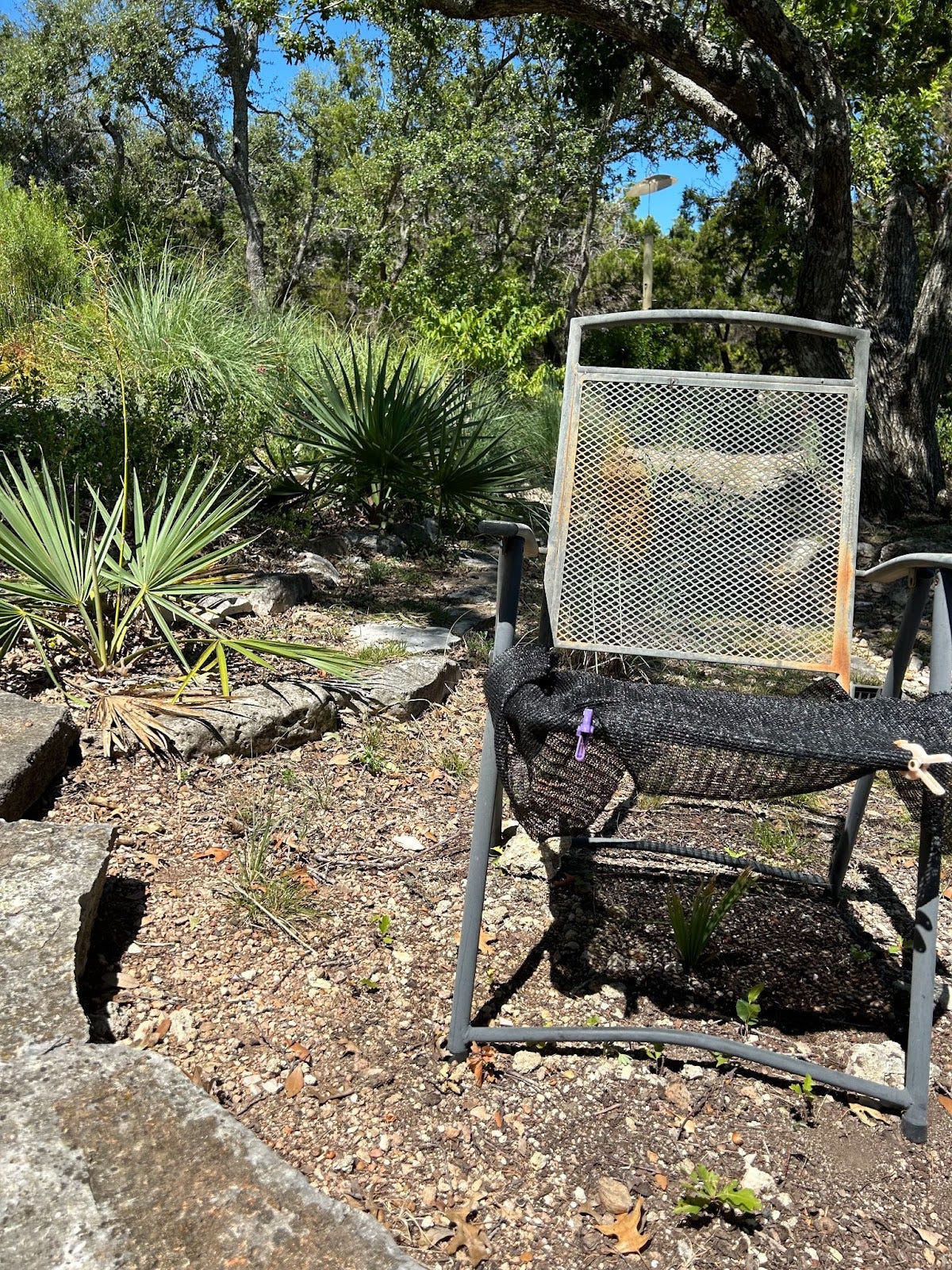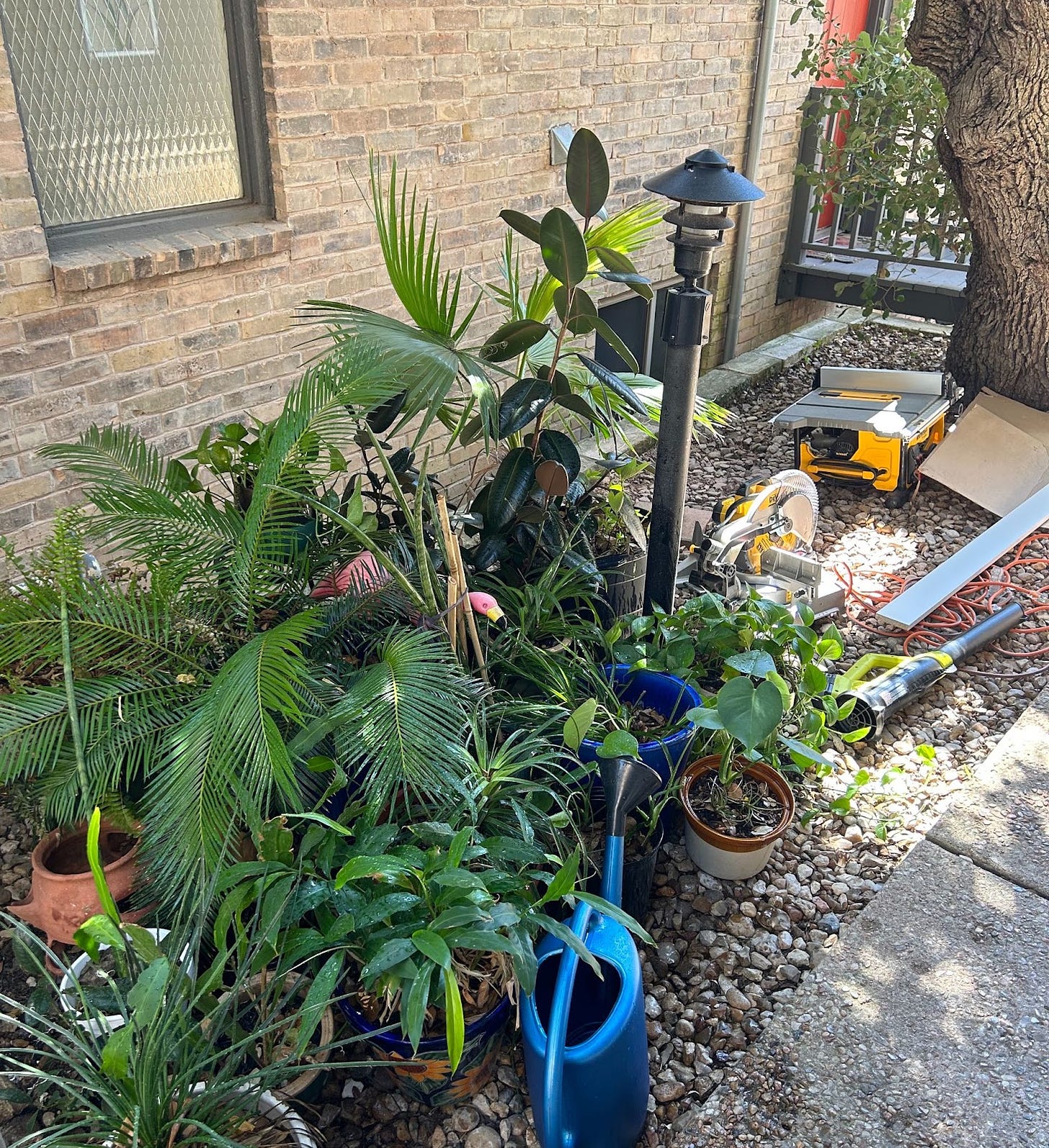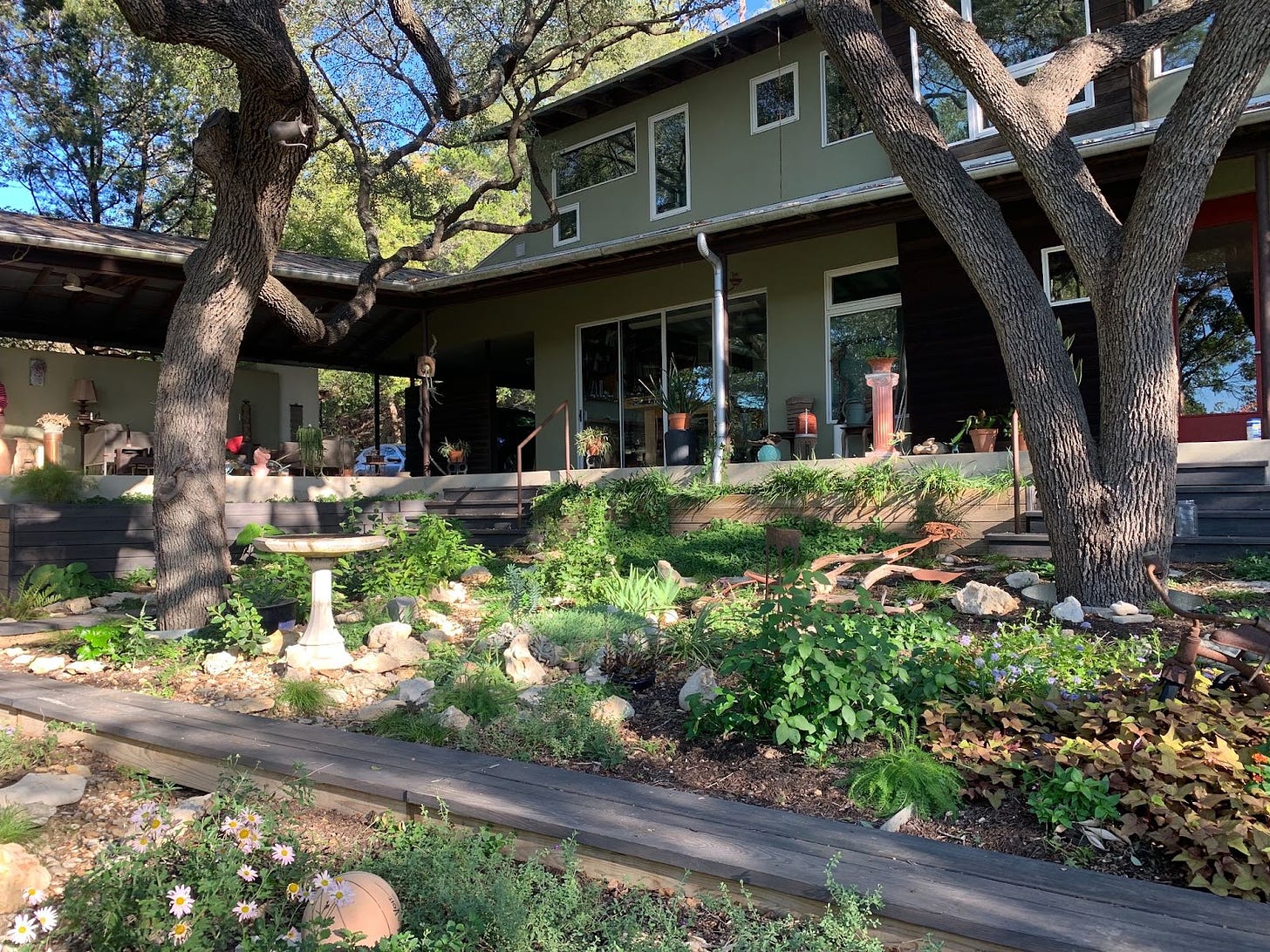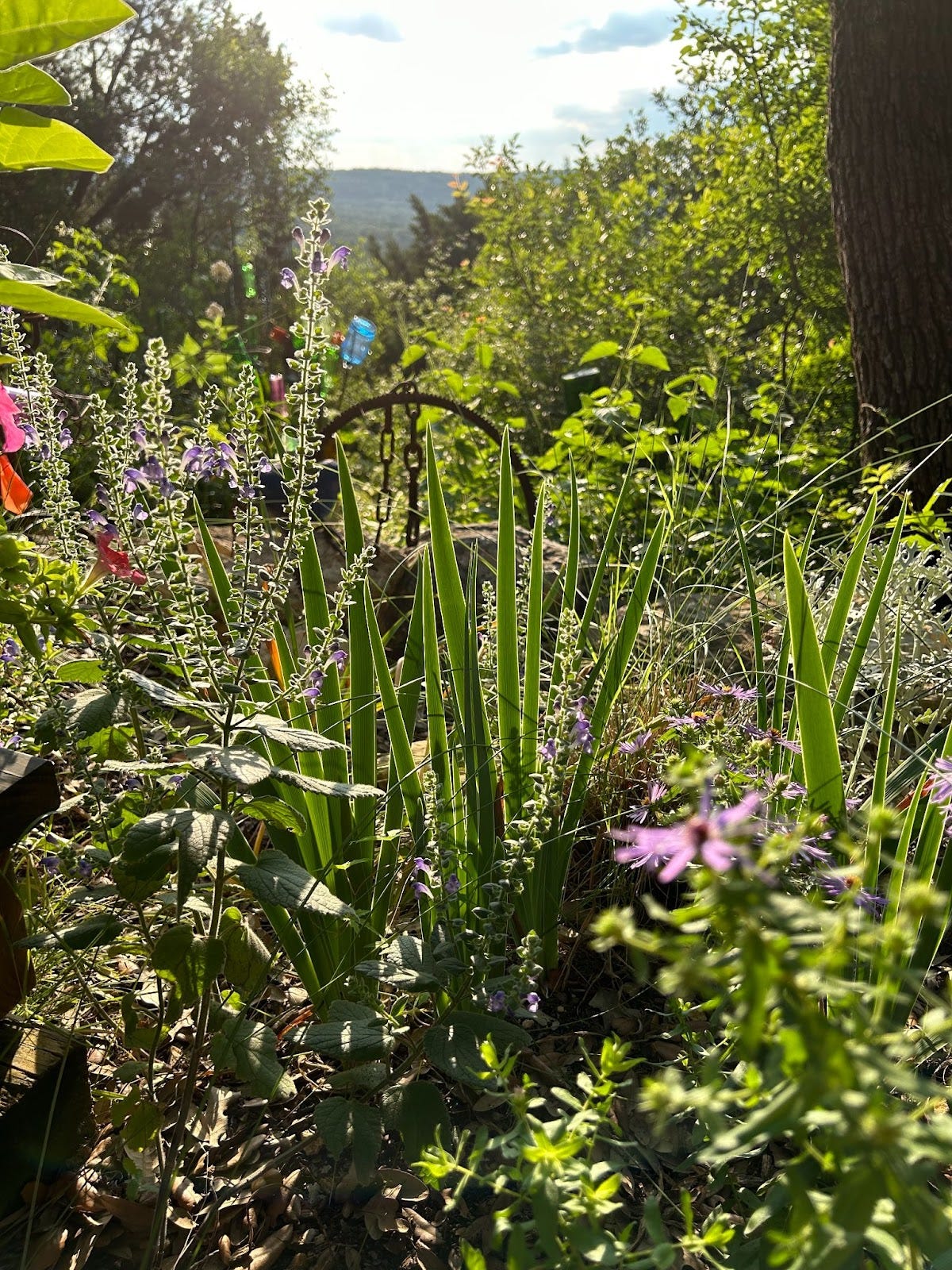Crappy Gravelscaping & Rescuing Plants from Demo Zones
"A lot of my job is educating people about how resilient plants can be."
Welcome to this week’s Garden Study Interview (Edition Four) — this week we have a professional gardener who doesn’t have a garden herself but hosts a lovely plant hospital on her patio. She also has all sorts of advice about xeroscaping/gravelscaping (and why it’s probably not the solution you’re looking for) and water-wise gardening….and how to rescue plants from demo sites. It’s a real joy.
The basics of the Garden Study Interview:
You don’t have to be an expert, just enthusiastic
I make a document with some basic questions and send them off; if you have ideas for questions to include in future Q&As, put them in the comments
The goal is to include all types of gardening (container, flower, patio, community, desert, mountain, vegetable you name it) and zones; please be patient, I promise we’ll get to all of them
The comments are what really make this space shine, so please do so with abandon (and go back and check out new comments on older posts, like last week’s on dahlias). You can find all previous issues editions here.)
And as always, if you know someone who’d like Garden Study, please forward this their way — but make sure to guide them to the specific way to *opt-in* to Garden Study emails, which you can find here.
And if you’d like to volunteer for a future Garden Study interview, here’s where you sign up (it might take years to get through them all, but I’m committed)
Now, get ready to have your mind blown a little or a lot about xeroscaping….
Name and Pronouns:
Leah, she/her
Where do you garden? [AHP Note: If you ever need proof that you always need more contextual Zone information, it’s that Austin is the same zone as me on a coastal island in the PNW that never goes above 80 degrees]
Austin, Texas, Zone 8b. Humid subtropical. People who move here are surprised to learn that it’s not the desert. Austin’s average annual rainfall is just a few inches shy of Portland’s, but we get precipitation in periodic flash floods rather than little by little. Unfortunately drought has dominated in the past several years. Summer 2023 has us parked under a “heat dome,” creating the longest stretch of hundred-degree temps in 125 years and no rain. Last week we blew past the all-time record (27 days) and it’s not going to cool down anytime soon. Gardeners get S.A.D. during the summer here, rather than the winter. Wealthy people leave town.
Much of Austin sits on a limestone aquifer, so our water is hard and our soil is alkaline, rocky, and sometimes clayey, depending on location. But we also have lovely natural springs, a dense urban canopy, and many creeks ringed by greenbelts with interconnected hike and bike trails.
Winters tend to be mild, but we’re seeing more ice and snow storms in recent years. Our power grid, roads, and other infrastructure are woefully unprepared for these.
Due to brutal summers, we have two growing seasons for vegetables: March-June, and October-December. My focus is on perennials and wildlife gardens rather than veggies, so here’s my planting schedule: woody perennials and trees go in the ground between October and March; herbaceous perennials, between late March and early June. During the cruel months of July, August, and September, it’s best not to plant anything.
Still the city is beautiful enough in the fall and spring to support a strong gardening culture centered around local nurseries, the Lady Bird Johnson Wildflower Center, and an environmentalist (for Texas, at least) city government. Austin’s horticultural vibe is laid back and pragmatic: heavy on natives, because that’s what survives, and a little wild and wooly. We have a broad palette of xeric, mesic, and tropical plants, but a lot of things go dormant in the summer heat.
You garden for a living — and you garden at home. Can you first talk about your path to gardening full-time, and your philosophy as someone who helps others plan and care for their gardens?
I barely touched a plant until my 30s. I grew up in the indoorsy Dallas exurbs where people had lawns rather than gardens, but I was always interested in exploring wild spaces. As a kid I had a rock tumbler and a subscription to Ranger Rick. Each summer I would stay with my grandmother in Austin for a week and she’d show me around the parks and swimming holes with their WPA-rustic architecture. One of my favorite spots in town (then and now) is Mayfield Park, with its stately live oaks, palms, water gardens, and peacocks.
I came to Austin to go to college, spent most of my 20s in Brooklyn, then came back. I studied film archiving at NYU and worked in that field for awhile, then tried freelancing as a movie critic, but I wasn’t cut out for it. Around 2012, the alt weekly I wrote for was slashing staff, I’d missed the boat on Twitter, I realized I don’t like attending film festivals at all, and my mental health was not great!
Meanwhile, my aunt Tina had started a garden maintenance company and hired me to help her part time. She taught me how to plant, prune, and deadhead, and also how healing gardening can be. I noticed that my anxiety and depression would fade drastically on the days I worked outside. Tina retired just as I was getting excited about gardening, so I went to work for local nurseries for a year, took all the continuing-ed classes I could, then started my business, Delta Dawn Gardens, in 2015.
I’ve tried a lot of things since then: designing and installing; “fine garden maintenance” with an all-woman crew, then getting rid of the crew except for one person; working one-on-one with clients who like to garden; teaching design courses at the community college, and podcasting. Currently I co-host two shows with my gardening best friend, Colleen Dieter: a design podcast called The Horticulturati, and a call-in AM radio show called the Horticulture Hangover. (Both of these live on the same feed in Apple podcasts, Spotify, and other podcast players.)
Hands-on gardening has always been my main thing, but I just turned 40 and have decided to focus more on designing for do-it-yourselfers. I’ve kept a few of my long term clients because they’re always coming up with new problems for me to solve. I learned hand-drafting at community college, but that’s becoming a lost art. So now I’m trying to catch up on digital drawing. I use a program called Procreate for drawing on the iPad, but it has many limitations, so I’m working on learning some more architectural programs like Morpholio Trace and Sketchup.
I don’t have my own yard, so I get very attached to other people’s gardens. When I take on a project, I expect it to last at least two years so that I can design and plant things at the right time, in the right order. My philosophy is that you can’t design a space well without spending a season or two observing it, so we may as well do some weeding and pruning while we’re at it! A lot of my job is educating people about how resilient plants can be. Plants go dormant when it’s too hot and too cold, but they’re just doing what they need to do to survive. Fall is always the most beautiful time. Gardening teaches us patience.
I know you have *opinions* about xeroscaping, or at least the way the term is often thrown around or misunderstood. Tell us everything.
Xeriscaping is a term coined by the Denver Water Department in the ‘80s to promote water conservation. They set out a series of principles for designing a landscape that uses less water than the traditional American yard, all of which are considered common sense today, like using mulch, improving the soil with compost, planting natives, etc. It’s a great framework for approaching design and ongoing care. But somehow that framework has gotten lost over the years, and people have tended to equate xeriscaping with gravel and cacti. There’s confusion about the term – “xeros” is a Greek word for dry. People mishear it as “zeroscaping” and think zero water, zero plants, zero life. That’s not it. The original concept said, it’s ok to irrigate, but divide your irrigation into zones so that you can water appropriately based on the water needs of different types of plants. It’s ok to have turf, but be thoughtful about it; put it where it will serve some purpose, rather than having huge swaths of lawn.
There are climates where it would be appropriate to use a lot of gravel and cacti, like Tuscon, where they only get a few inches of rain per year. Here in Austin, where we get about 34” of rain annually on average, it’s not appropriate. Yet it’s happening all over the place. These lunar landscapes get installed because landscapers sell them as water-wise. We’re under water restrictions, so everybody’s just trying to do the right thing, but it’s a disaster.
Here’s why: a gravelscape may require less water than a lawn or a perennial garden, but it doesn’t help stormwater infiltrate, doesn’t provide any ecological benefits, and doesn’t sequester carbon. It compacts the soil, especially when plastic landscape fabric is used. It raises the ambient temperature, so your air conditioning bill goes up, and all that hot gravel is lethal to tree roots. We need trees to combat the urban heat island effect, and we need dense, diverse plantings to filter stormwater, shade the ground, and preserve the tiny thin layer of soil that supports life on earth.
On top of that, a gravelscape is hell to maintain. Pulling weeds out of gravel is miserable, so people use Roundup, which is toxic to people and wildlife. Leaves fall on the gravel and make it look messy, so people use gas blowers that emit tons of hydrocarbons into the atmosphere, when what we really should be doing is letting those leaves fall and do their nutrient cycling job.
Instead of ripping out a lawn and replacing it with gravel, here are some better things you can do to conserve water, which all fall in line with the original idea of Xeriscape:
Leave the leaves! Let leaves fall and decompose in your beds. Leaf mold is an excellent mulch and source of nutrients and beneficial fungi for the soil. Plus, it’s free! A healthy soil food web will produce all the macro and micronutrients most native plants need, and a healthy ecosystem will take care of your pest management for you. (If you can’t stand the look of leaves in your garden beds, you can cover them up with wood mulch. Nobody has to know.)
Mow at the highest possible setting, and mow less often. This goes for lawns, perennial gardens, and meadows. Perennials can be mowed for ease of maintenance and to reduce competition from volunteer trees, but it really only needs to happen once or twice a year.
Densely cover the ground with plants to shade the soil.
Okay now I want to hear all about your home container garden — what’s there, how do you care for them? Get as detailed as you’re willing when it comes to types of pots, watering schedule, fertilizing, protecting from animals, etc.
I live in a condo with some balcony and patio space, but no ground to plant in, so it’s all containers. It’s especially modest right now, because we are doing a major renovation and it’s a construction zone. I moved all the pots out by the front door where I can keep them watered and wipe the drywall and sawdust off the leaves. (Last week the contractor had a tile saw set up in this spot, today they’re sawing shelves.)
I haven’t thought of my assortment of plants as a “garden” because there’s little cohesion to it, but it’s a garden in its own way, part collection and part holding area/plant hospital – an assortment of divisions from yards I work in, passalong plants from friends, and stuff I’m propagating or rehabilitating for clients. The containers are all of similarly random provenance - nursery pots, pots people gave away, stuff I pick up at estate sales. Most of my gardening energy is expended in my clients’ gardens, so these plants have to thrive on benign neglect. I water them about every few days during the summer (the 2-gallon watering can I got for Christmas is a game changer) and I don’t fertilize anything. I divide and repot things with really good potting soil every year. If I spend money on one thing, it’s potting soil. (Fox Farm Happy Frog is my go-to.)
Aside from the temporary plants I’m growing for clients, most of my own plants are tropicals: cycads, palms, arums, bromeliads. Houseplants, basically, but they stay outside probably 355 days a year. They like the shade and the humidity and don’t mind the heat. Our complex has a decommissioned laundry room that my neighbors and I have turned into a makeshift greenhouse. When it gets cold, my husband helps me move pots in and out. In winter here it’ll be 40 degrees one day and 70 the next, so there’s a lot of schlepping pots in and out. Thankfully the “greenhouse” is a few steps from my front door.
I wasn’t always so utilitarian about my home garden. In 2015, the Austin PBS show “Central Texas Gardener” filmed an “garden tour” segment at my condo (it aired in 2016). I gave a lot of advice about container gardening, some of which I still agree with, most of which I don’t. I was so naive! Most of the plants in that video are long gone, but a few are still with me. Here’s what I’ve learned since then: failure is a great teacher. When plants die on your watch, don’t beat yourself up. Compost your mistakes. Keep going. Keep learning.
What’s your philosophy when it comes to plant rescue?
My neighborhood is full of cute little ranch houses built in the 60s. Developers are gradually tearing them down and putting up huge Modern Farmhouse McMansions. (Not my taste, but real estate is what it is.) When a house is slated for teardown, the builder puts up construction fencing and a demolition notice, and then they wait several months for permitting.
My client Lori introduced me to the hobby of “rescuing” plants from teardowns, which combines the thrill of trespassing and the lure of free plants. I don’t think of it as theft; anything inside that demolition fence will be razed and no one will miss it. Digging up plants to save them from the bulldozers is a little protest in the face of overdevelopment and habitat loss. I’m always on the lookout for rare native perennials and things that are hard to find in nurseries. Sometimes I just collect seeds. I keep potting soil and extra nursery pots in the car in case I need to pull over. I pot up my finds and nurse them along until they get some new roots growing, then give them away to clients and friends. It’s fun.
If a friend was starting with a blank slate of a garden in a climate similar to yours, what three plants would you recommend as steady, reliable workhorses?
Fall aster (Symphyotrichum oblongifolium), frostweed (Verbesina virginica), and the skullcaps (Scutellaria spp.) come to mind, but in extreme heat and drought, plant selection only matters so much. Even when going all-native, it all comes down to the power of the sun. Afternoon sun, especially, is killer. So what I’d recommend for people gardening in hot places are some cultural things:
1.) Put a physical barrier between the sun and the soil. Natural shade from trees and densely planted perennials are best, but if you don’t have that, use leaves, mulch, shade cloth, furniture, whatever!

2.) Hand water the soil. We’re under heavy water restrictions, but the rules usually allow for some hand-watering. During drought, I like to get a small hose-end sprinkler going on a very low setting (the spray should be a foot tall or less) and let it soak the ground. Set a timer for 20 minutes, move the sprinkler, and repeat. This can take awhile, but you only really need to do it once a week for highly maintained areas. Most plants prefer a periodic soaking to frequent shallow watering. (A case could be made that using a sprinkler isn’t “hand watering” but I would argue that this method causes far less evaporation than standing around and spraying the tops of the plants like a fire hose!)
What do you most often think about (or listen to) when you’re out in the garden?
Podcasts. I always have my earbuds in. I edit The Horticulturati, and I usually give it multiple listens through the process to figure out where I want to make cuts or add music. But I listen to a ton of podcasts. I love Jack Wagner’s Otherworld, Karina Longworth’s You Must Remember, and a bunch of Bravo-adjacent and Drag-Race-adjacent shows.
What are your future dreams for your garden?
Rain. Just some rain would be a dream come true.
Finally, this is your chance to crowdsource freely from the Garden Study community. What do you want to ask?
How do you water houseplants?? I had a kitty for nine years who was a ravenous eater of houseplants, so my houseplants have mostly lived outside. She passed away on May 8. Now I have the ability to bring plants indoors, but I’m so used to just filling up the ol’ watering can and giving them a good sloppy soak outside where they can drain freely and not make a mess all over my floor. Would love to hear any tips for watering indoors!









I'm a 9b semi-arid (not quite a desert) person and we ripped out our lawn for gravel and BOY HOWDY do I regret it now. We talked to so many people before we did it, and they all said to use landscaping fabric to keep weeds away, and NONE of them mentioned they actually use Round Up. Re-doing all of that will be a project for when both of my kids are in school next year.
Watering houseplants: for my bigger, more established plants, I use terra cotta watering spikes with old wine bottles (this doesn't work with smaller pots that can't counter the weight of a full wine bottle) - water eases into the soil over a week or so and everyone stays happy. For smaller plants, I handwater from the top once a week or so, but I'm waiting for my kickstarter reward to come in with a bunch of bottom watering pots to try those out. If my plants can't handle either of these methods, they are too high-maintenance for me and I probably killed them off... I should add that I refill the wine bottles when I think about it or when the plants tell me they're getting a little dry. My 6 year old Pothos is a really good communicator.